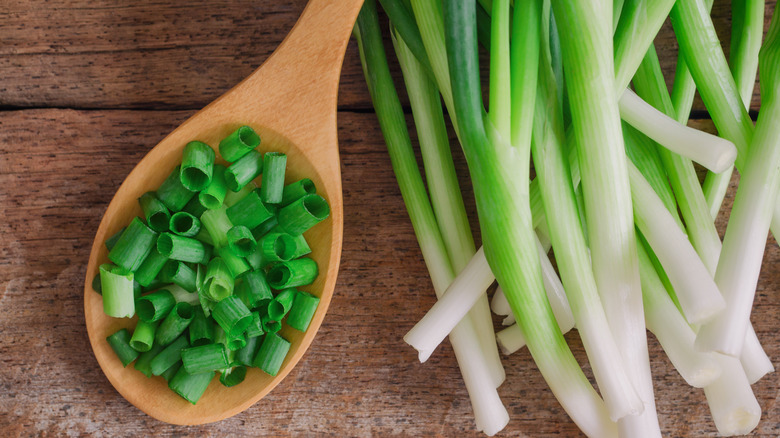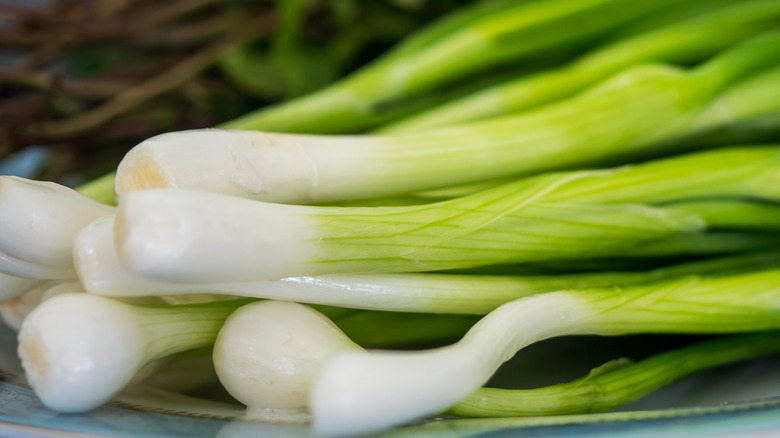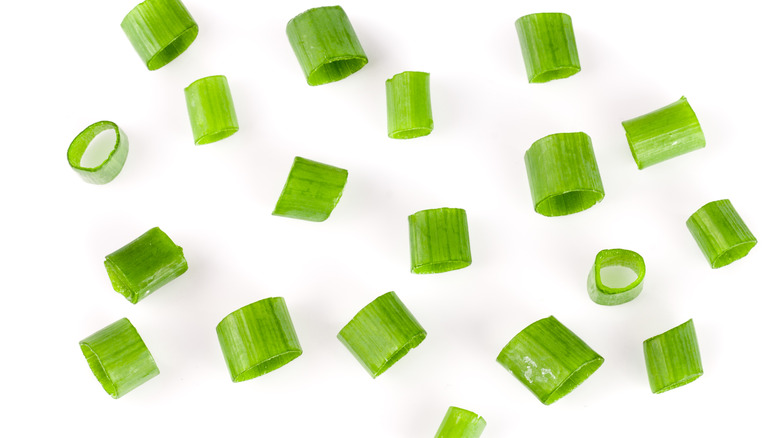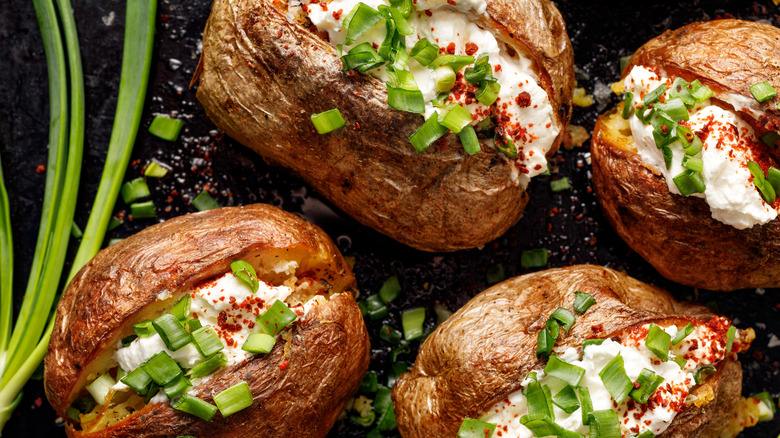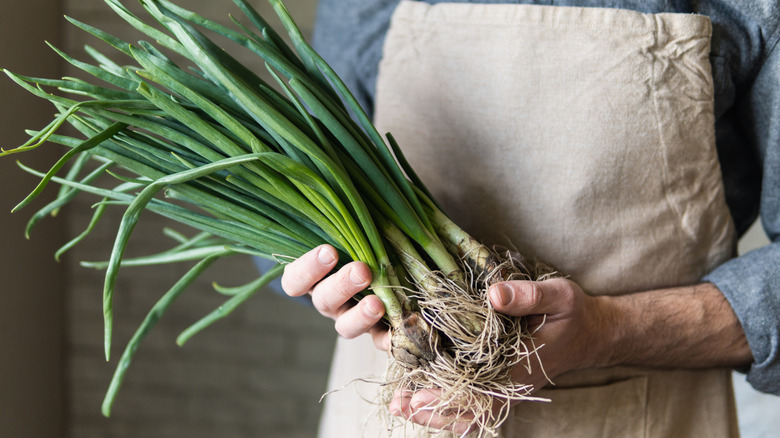What Are Scallions And How Do You Use Them?
Scallions are an extremely popular and versatile ingredient that you can use in many different dishes. While they're rarely ever the main focus of a dish, their added flavor and flair can certainly be the star of the show. Scallions are pretty easy to find, and though they're often confused or interchanged with green onions, they are a useful cooking element with a flavor profile and tangibility all their own.
Scallions are a type of bulb vegetable plant that are native to central China (via Missouri Botanical Garden) and grow in long, green stalks, which can be anywhere from 8 to 12 inches tall. Despite being native to central China, scallions are extremely easy to grow pretty much anywhere — even in your own backyard or windowsill herb garden. Scallions are part of the Allium genus in a subfamily called Allioideae, which is also home to onions, shallots, leeks, garlic, and chives (via Britannica).
What do scallions taste like?
Scallions are sometimes used as a fragrant or flavorful garnish or cooked and incorporated in a dish to add a certain taste element. So what do they taste like, exactly? For starters, scallions can be eaten in almost any form, whether raw in a salad or fully and thoroughly cooked like on the grill or in a stir fry., according to. They taste similar to standard white onions, but with a sweeter and milder flavor. What's also interesting about scallions is that, since they are a bulb plant, they essentially grow to have two distinct parts which carry their own flavor: the white base of the stalk, and the well-known, vivid green length of the stalk (via Masterclass).
For those slightly familiar with scallions, you probably know the vegetable-based on a chopped version of the green stalks. But often, recipes will utilize the full potential of scallions by having the cook separate the white parts from the green since they contain slightly different flavor profiles (via Fine Cooking). The white part of the scallion has a flavor that is most closely related to onions, but again, sweeter and milder. The green part has that sweet, mild, oniony flavor, but with a grassy, earthy element, too. Overall, scallions have a bit of a sharp bite, a slightly acidic-yet-sweet and grassy flavor.
How do you cut scallions?
There are a variety of ways to prepare and cook scallions, depending on the strength of flavor and texture element you're looking for. A common practice is to finely chop scallions crosswise, resulting in small, thin ringlets (and of course, separating the greens from the whites). You'll want to cut off one to two inches off the tops of each stalk to get rid of any imperfections and wilted leaves. Additionally, you'll want to cut off the root of the scallion at the very base of the stalk. Depending on how much of the white part of the scallion you need or want to use can determine how close to the roots you cut (via Clean Green Simple).
Another method is to slice the scallion stalks lengthwise into very thin, hairlike pieces, according to Serious Eats. This method will result in a slightly less intense flavor than if you opt for the ringlet cuts. For dishes like stir-fry, which contain heartier bits of vegetables, you can consider cutting the scallions into larger chunks (crosswise). This method is the best way to use the majority of the scallion base or white part of the scallion, where the stalk is thicker and won't wilt as much upon cooking.
How do you cook scallions?
Scallions are popular for many dishes, especially for Asian-inspired recipes. As mentioned, scallions have enough of a flavor but are also mild enough to enjoy raw, fully cooked, or somewhere in the middle, and can be used as a garnish, added flavor element, or a more hearty, central ingredient.
You'll often see scallions in dishes like ramen and stir-fry. They can also be used to top soups, add a slight onion flavor to a sweet dish like orange chicken, or in cheesy dishes like loaded baked potatoes. Food & Wine lists several ways you can use scallions, including in salads, savory baked goods (think: cheddar biscuits), or within any of your favorite noodle dishes, particularly ones with Asian-inspired sauces.
If you're cooking scallions and have properly washed and cut them, you can cook them really in any way — a popular method includes sautéing chopped scallions in oil or butter (sometimes with other chopped onions, garlic, or herbs and seasonings of your choice). If baking with scallions, you'll typically incorporate them into a base or mixture and simply pop that dish in the oven.
Scallions vs. green onions vs. spring onions
Scallions and green onions are often referenced interchangeably in recipes. And, despite being labeled differently at grocery stores, they are virtually the same thing (via Bon Appétit). Spring onions, however, are not the same as scallions and green onions and should not be used interchangeably. While scallions or green onions have a small, white base where the bulb and roots grow, they typically do not form full bulbs as spring onions do. Spring onions are also generally sweeter in flavor than scallions or green onions, and therefore make good substitutes for sweet onions.
Visually, scallions and spring onions look quite similar, but the truth lies in the bulb (or lack thereof) at the end of the stalk. If the base is pretty small and close in size to the rest of the stalk, it's a scallion (or green onion). If a full, round, and large bulb lies at the end of the stalk, it's most likely a spring onion (via Bon Appétit).
Where to buy scallions and how to regrow them
Scallions are pretty easy to find and should be available in nearly every grocery store or produce market. In a standard grocery store, you'll find them in the produce aisle close to other fresh herbs. (Note: They will not be in the dry produce with white or sweet onions.) When you're selecting your scallions for purchase, you'll want to look for bright green, healthy-looking, and firm stalks, according to Allrecipes. You'll want to stay away from any scallions that look brown, slimy, or wilted, and these signs are a good indication that they have spoiled if they're currently in your fridge.
And speaking of storage, you'll want to keep scallions refrigerated as they'll last a bit longer than if kept dry and at room temperature. A good reminder is how you found them at the grocery store: cool and refreshed! To go above and beyond simply throwing scallions into your fridge's produce drawer, consider placing your scallions in a jar of water that's filled just enough to fully submerge the roots and base of the scallions. You can also regrow your scallions! A Piece of Rainbow says to place the root ends of your cuttings in a jar and leave it in a bright spot. After a week or so, you should have scallions growing back and ready to harvest.
